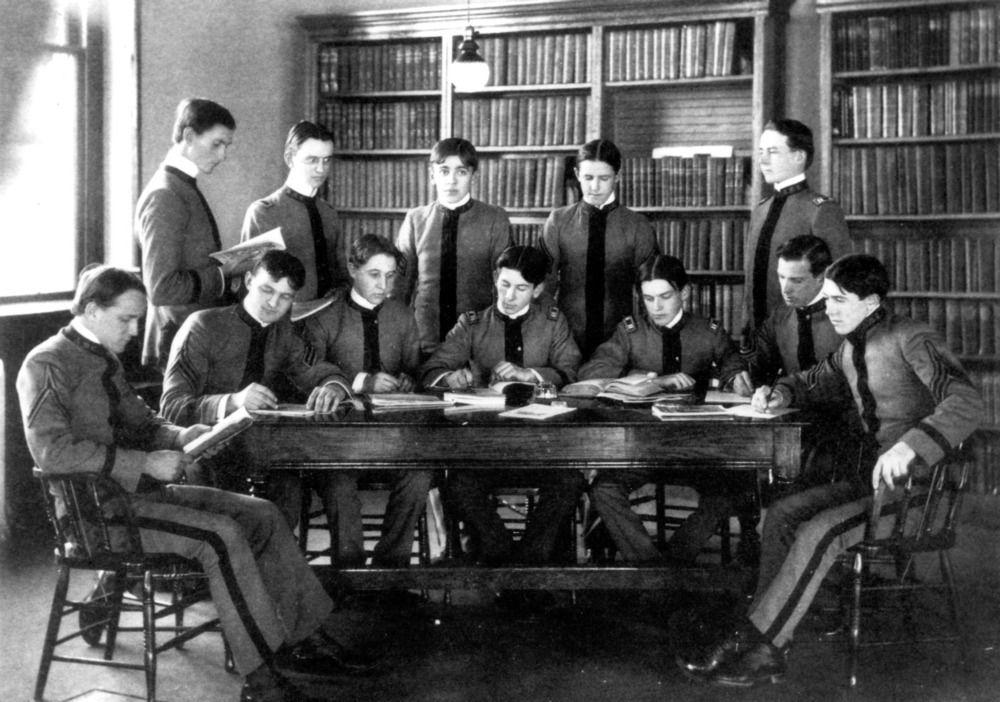
Red and White board of editors, 1904. Student Media Archive photo.
Under the sponsorship of the Athletic Association in 1899, the North Carolina College of Agriculture and Mechanic Arts organized its first student publication, The Red & White. This literary magazine consisted mainly of poems and short essays. During its time, the student editors conformed to the viewpoints of the college in order to avoid conflict and backlash.
In 1911, The Red & White expanded when the literary societies of the North Carolina College of Agriculture and Mechanic Arts took control of The Red & White, and the Athletic Association formed a new publication called The Wau Gau Rac. Both publications coexisted until 1915, when The Wau Gau Rac was discontinued by the college for financial reasons.
In 1917, The Red & White ceased publication because of World War I. In May 1917, the Board of Trustees appropriated $100 to help with printing expenses, but the amount wasn’t enough to sustain the production of the paper, according to a 1920 edition of Alumni News. The only student media outlet to survive the war was Agromeck, the college yearbook.
Then, on Feb. 1, 1920, Technician released its first edition as the new student newspaper on campus. Technician initially supported its production by offering subscriptions for 50 cents per term. Its first issue was modest: about 8 x 12 inches, only four pages and containing five advertisements. The next issue doubled in length and brought in 17 advertisements.
Marion Francis Trice served as the first editor-in-chief and John Guy Stuart the business manager. In the first issue, the editors argued for Technician’s existence, saying that if a smaller student body could produce The Red & White, then the current student body of more than 1,000 students would surely be better equipped for a larger task. A piece of the inaugural editorial read, “College life without its journal is blank.”
Unlike The Red & White, Technician functioned as an independent voice for the student body separate from the administration’s influence. The first issue described its function: “A paper that is entirely the product of the student body becomes at once the official organ through which the thoughts, the activities, and in fact the very life of the campus, is registered. It is the mouthpiece through which the students themselves talk.”
The first year of publication was a struggle. On May 17, 1920, J.D. Miller was elected as the new editor-in-chief but then announced his resignation to the public on Nov. 15, 1920, and J.H. Lane resumed his position.
The first volume lasted more than a year, from Feb. 1, 1920 to Apr. 1, 1921. The staff then decided to change volumes each school year instead of on the date Technician was founded.
E.C. Tatum, editor-in-chief from Oct. 15, 1921 to May 25, 1922, changed Technician’s flag from bold block letters to Old English typeface during the second volume and also added “The” to the official name. Technician has gone through many flag changes since then.
Early Technician editorials expressed opinions about the need for a student government, a concrete sidewalk and a new gymnasium.
The 1922 staff wanted to publish weekly because of the newspaper’s growth. However, the college trustees refused to allow the Technician staff to collect subscription fees from every student at registration, which prevented them from publishing more frequently. The staff encouraged current and former students as well as faculty to subscribe to the paper so they could achieve their goal.
By the spring of 1922, Technician was able to print once a week with new subscription fees of $2 per school year.
That year, Technician left a box in the dining hall for students to submit contributions to the paper, which said, “If you hear a good, clean joke, jot it down and hand it in; poems are also welcomed and especially original compositions. Your articles will receive due credit from the Managing Editor however short.”
Editor’s note: this article’s headline has been updated for accuracy.